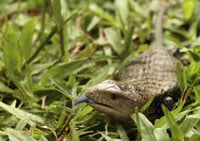Blue-tongued skink feeds on toxic plant that has same toxin as toad.
An invasive plant may have saved an iconic Australian lizard species from death at the hands of toxic cane toads. According to Richard Shine, a biologist at the University of Sydney who led the research, it's an interesting case of one invasive species preparing local predators for the arrival of another.
The Threat from the Toads
Cane toads were introduced to Australia in the 1930s to control beetles that destroy sugar cane crops, but the toads quickly became an ecological disaster of their own. They produce toxins called bufadienolides, which have proven deadly to many native Australian species that feed on frogs and toads.
Blue-tongued skinks are one of the vulnerable species, and their numbers began to shrink significantly after the toads arrived in northern Australia. But there's reason to believe that blue-tongued skinks populations elsewhere in Australia will fare better as the toads spread across the continent.
"Our study was stimulated by a puzzling observation that arose during research on the ecological impacts of invasive cane toads" explains Shine. "Some lizard populations were vulnerable to bufotoxins whereas others were not—and the populations with high tolerance to bufotoxins included some that had never been exposed to toads."
Mother-of-Millions
Why would these populations have evolved a tolerance to the toad toxin when no toads were present? The answer, according to Shine and his colleagues, is likely to be an invasive plant species known as mother-of-millions, which happens to produce a toxin that's virtually identical to that of the cane toad. After it was imported from Madagascar as a decorative plant some 70 years ago, mother-of-millions has since run amok in parts of Queensland and New South Wales and become part of the diet for local blue tongues.
Shine and his colleagues collected blue tongues from places with and without mother-of-millions, and injected each of them with a tiny amount of cane toad toxin. They found that toads from places where mother-of-millions is common had less of a reaction than those from places where it was absent. The results suggest that the plant drove strong selection for lizards that could tolerate bufotoxins—a remarkable example of evolution over a relatively short period of some 20 to 40 generations of lizards.
"Now it appears we have a population of eastern blue-tongue lizards that are able to defend themselves well against cane toads—even though they've never actually met one—whereas the devastation of the cane toads on the northwestern lizard population continues," Shine said. "Eating this plant has pre-adapted the eastern blueys against cane toad poisons."
The Australian government has spent millions trying to deal with the toads and mitigate their ecological impact, but Shine's work suggests the eastern bluetongues might not need much help. "We're now able to focus our conservation dollars on those populations that can't care for themselves," he adds.
Reference: Samantha J. Price-Rees, Gregory P. Brown, Richard Shine. Interacting Impacts of Invasive Plants and Invasive Toads on Native Lizards. The American Naturalist, 2012; 179 (3): 413 DOI: <10.1086/664184>


